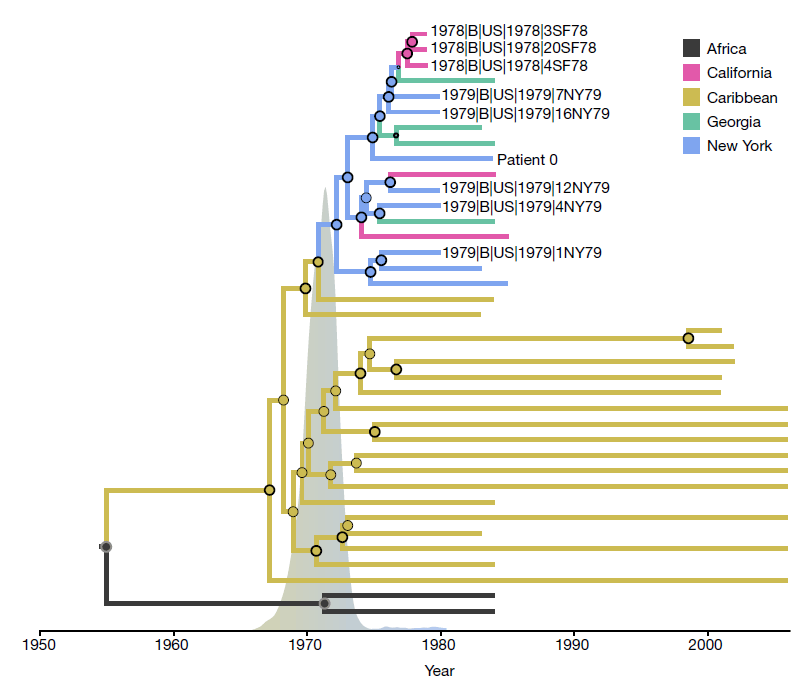HIV null patient likely flew to New York from Haiti in 1971
 Zero patient (index patient) - this is the name in medicine of the person with whom the epidemic began. This is the very first infected individual.
Zero patient (index patient) - this is the name in medicine of the person with whom the epidemic began. This is the very first infected individual. For example, take the global HIV epidemic, which has swept almost all countries and claimed the lives of more than 25 million people. Every day, 14 people die from this disease, and approximately 42 million live with the virus. Although the infectious disease is now well understood, the pace of its spread is still high, the number of infected and the number of deaths is increasing.
For a long time it was thought that the global HIV epidemic began with one man gay named Gaetan Dugas (Gaëtan Dugas), pictured. He was called patient zero. An international team of scientists has now conducted a genetic study of early HIV samples.and found out some details of how things really were.
Gaetan Duga (1953−1984) became widely known as a null patient after the publication of the book “And the Orchestra Continued to Play” in 1987 by journalist Randy Shilts. The author of the book figuratively called the hero a “zero patient” for his promiscuous sex life, which caused thousands of people to get the infection - and it could not be stopped in the United States. Gaetan was a flight attendant for Air Canada and, by his profession and appearance, was ideally suited for the rapid spread of infection throughout the country.
The view that Gaetan Duga is a null patient has become widespread in society. But from a scientific point of view, this is not so. Before him there were still infected people from whom Gaetan received the virus.
The results of the genetic study were published by a group of scientists led by evolutionary biologist Michael Worobey. She found out that Duga could not be a zero patient in the USA. The initial infection occurred at another time and in another place.
Until recently, scientists had the only genome sample of a patient with HIV-1, dated before 1980, and this patient was from Africa. At the same time, doctors were inclined to believe that the global HIV epidemic began in the United States. But the study of this topic was hampered by the lack of genomes of infected patients. To fill this gap, Michael Sparrow and colleagues screened and sequenced blood samples from homosexual patients from New York and San Francisco in 1978–1979. Nobody knew about HIV at that time, but gays were taking samples for hepatitis B, and the serum has been preserved to this day.
Among 2231 samples, 83 were positive for HIV-1. Twenty of them were subjected to genome sequencing. Researchers have perfected the technique to greatly increase the likelihood of detecting HIV-1 in samples and to extract the complete genomic sequences of HIV-1 from them. Five samples from New York and three from San Francisco provided enough data to assemble the genome, that is, to combine a large number of short DNA into a long sequence. A Bayesian phylogenetic analysis of these HIV-1 genomes was performed. The result is shown in the diagram.

Analysis showed that although these samples are the oldest samples outside of Africa, they do not touch the main branch even for subtype B (this subtype of the virus dominates in Europe and the USA, while subtype A dominates in some regions of Africa). Instead, the American HIV genomes of the 1970s and the entire American epidemic as a whole phylogenetically branched off from the more genetically diverse and old subtype B epidemic in the Caribbean - Haiti, Dominican Republic, Trinidad and Tobago, Jamaica. HIV-1 samples from emigrants from the Caribbean are shown in gold in the diagram.
Based on the available data of phylogenetic analysis, scientists concluded that Caribbean HIV-1 samples are American ancestors (99% probability) and come from an ancestor from the 1963-1970 interval (95% probability). All this allows us to confidently assume that the HIV epidemic came to America from the Caribbean, and not vice versa.
Geographic analysis and dating of HIV-1 samples by molecular clock allows a fairly accurate guess on the date that HIV came from the Caribbean to the United States. This probably happened in 1971, long before blood samples were taken, which experts are now analyzing.
The following diagram shows the dates of the alleged infection by molecular clock and the estimated route of HIV transmission. Scientists suggest that the virus came from Africa to Haiti (the date of this transition is unknown). From Haiti, he went to New York, and from there spread throughout the United States and around the world.
However, the flight attendant Gaetan Duga was completely not involved in this, so his memory can be considered cleared of dirty insinuations. He was not the zero patient.

Cluster of sexual contacts of 40 patients infected with AIDS at the beginning of the spread of infection. Zero patient is marked with the number 0 (index patient)
The spread of HIV infection began in New York and San Francisco in 1971, at the height of the sexual revolution, under the slogans of the hippie movement. People who believed in beauty and freedom were very loving - and many became victims of the deadly virus.
The scientific work was published on October 26, 2016 in the journal Nature (doi: 10.1038 / nature19827, pdf ).
